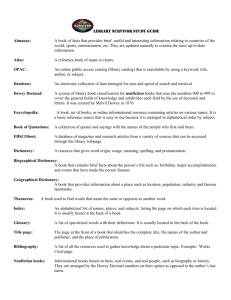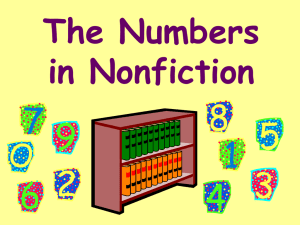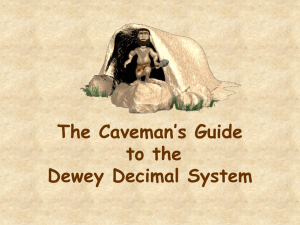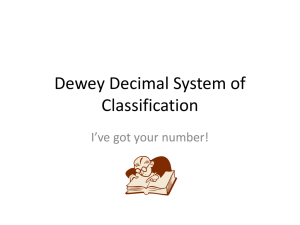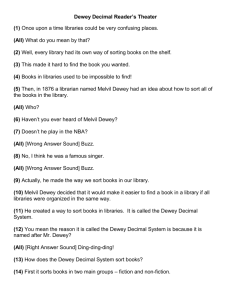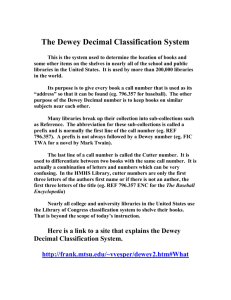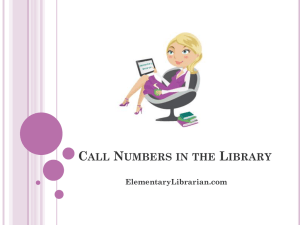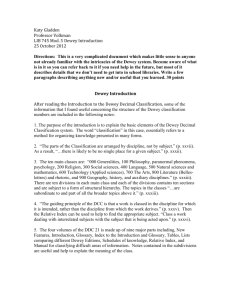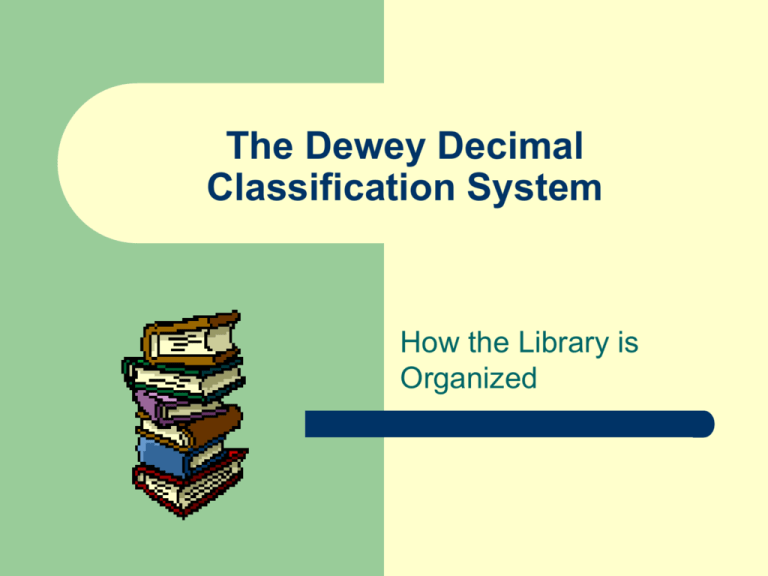
The Dewey Decimal
Classification System
How the Library is
Organized
Melvil Dewey 1851-1931
In 1876, Melvil Dewey
devised a system of
organizing books.
He divided books up into
10 main subjects, and
then assigned these
subjects a number.
That way all the books
on a topic would be
together on the shelf.
The Dewey Decimal System
Mr. Dewey’s idea was so
good, it has lasted for
130 years so far and
spread to more than
200,000 libraries in
135 countries around
the world!
What is a Call Number?
Every book in the library is given a unique call
number that is an address for locating the book
on the shelf.
The call number is located on the spine of a
book.
The call number is made up of two parts: the
Dewey Decimal classification number and the
first three letters of the author’s last name.
The Key to Library Call Numbers
CALL NUMBER
TYPE OF BOOK
HOW IT IS SHELVED
E
ALPHABETICALLY BY
AUTHOR NAME
FIC
EVERYBODY =
PICTURE BOOKS
FICTION = CHAPTER
000-999
NONFICTION
DEWEY DECIMAL NUMBER,
THEN AUTHOR NAME
92 OR 921 OR
B
BIOGRAPHY
DEWEY DECIMAL NUMBER,
THEN SUBJECT’S NAME
REF
REFERENCE
DEWEY DECIMAL NUMBER,
THEN AUTHOR’S NAME
ALPHABETICALLY BY
AUTHOR NAME
The Difference Between
Fiction and Nonfiction
Fiction
Books that are stories
made up by the author.
They are not true, but
might be based on true
events.
Nonfiction
Books that are about
real things, people,
events and places.
They are true, except
for fairy and folk tales
in 398 and literature in
the 800s.
Fiction and Nonfiction
Call Numbers
Fiction call numbers
begin with E or FIC or F,
and then the first three
letters of the author’s
last name. It’s still a call
number even though
there are no numbers in
it!
Nonfiction call numbers
begin with a Dewey
number, and then the
first three letters of the
author’s last name.
599
E
FIC
SEU
PAU
GIB
Just Remember…….
FICTION CALL
NUMBERS HAVE
ONLY LETTERS!
NONFICTION
CALL NUMBERS
HAVE NUMBERS
AND LETTERS!
+
The Dewey System Has 10 Main Classes
for Organizing Nonfiction Books.
Dewey #
10 Main Classes
000-099 General Works
Kinds of Books
Encyclopedias, almanacs, record
books
100-199 Philosophy and Psychology
Paranormal phenomena, ethics,
how we think
200-299 Religion
300-399 Social Science
Bible, mythology, religions
400-499 Language
English and foreign languages, sign
language, dictionaries
500-599 Natural Science
Math, chemistry, biology, weather,
plants, animals
600-699 Applied Science
Inventions, transportation, cooking,
pets
700-799 Fine Arts and Recreation
Crafts, painting, music, games,
sports
800-899 Literature
Poetry, plays
900-999 History and Geography
Countries, flags, biographies about
famous people
Government, holidays, fairy tales,
education, community
Each of the 10 Main Classes
can be further divided:
From Broad…
…to Specific
500
Natural Science
590
Animals
599
Mammals
599.8
Primates
599.88
Apes
Dewey and Decimals
Think of a Dewey number as if it were dollars
and cents! For example:
595.23
Comes Before
595.30
When in doubt, add a 0 (zero) to even out the
digits after the decimal.
Locating a Book
on the Shelf
Remember this rule for how books
are usually shelved!
You start at the left on the top
shelf, and move to the right
until the shelf ends. Then you
go to the next shelf beneath
that, and do the same-left to
right, top to bottom, just like
you read a page in a book!
In Conclusion:
Once you understand the Dewey Decimal System of
organization, you can find your way around most public
and school libraries.
Now watch, read, and think to understand the advanced
Dewey PowerPoint presentation. See what you already
know from this PowerPoint, and what is new in the
advanced version.
Presentation created by:
Julie Favero and Diana Dorney,
Librarians, Lake Oswego School District
Adapted with permission by:
Garnetta Wilker, District Librarian,
Oregon Trail School District, September 2004
Adapted further, with permission, by:
Ms. Tini Maier, Teacher Librarian, November 2013
All Rights Reserved
May not be used without permission

